
A regiment is a military unit. Its role and size varies markedly, depending on the country, service, or specialisation.
Corps is a term used for several different kinds of organization. A military innovation by Napoleon I, the formation was first named as such in 1805. The size of a corps varies greatly, but two to five divisions and anywhere from 40,000 to 80,000 are the numbers stated by the US Department of Defense.
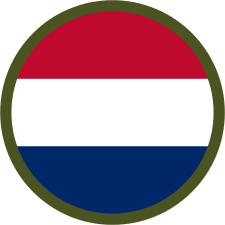
The American Expeditionary Forces (AEF) was a formation of the United States Armed Forces on the Western Front during World War I, composed mostly of units from the U.S. Army. The AEF was established on July 5, 1917, in France under the command of then-Major General John J. Pershing. It fought alongside French Army, British Army, Canadian Army, British Indian Army, New Zealand Army and Australian Army units against the Imperial German Army. A small number of AEF troops also fought alongside Italian Army units in 1918 against the Austro-Hungarian Army. The AEF helped the French Army on the Western Front during the Aisne Offensive in the summer of 1918, and fought its major actions in the Battle of Saint-Mihiel and the Meuse-Argonne Offensive in the latter part of 1918.
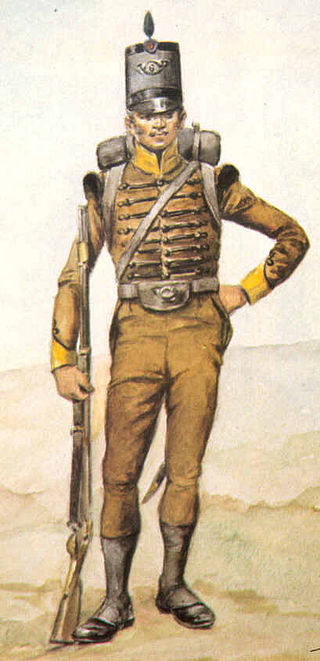
Light infantry refers to certain types of lightly equipped infantry throughout history. They have a more mobile or fluid function than other types of infantry, such as heavy infantry or line infantry. Historically, light infantry often fought as scouts, raiders, and skirmishers. These are loose formations that fight ahead of the main army to harass, delay, disrupt supply lines, engage the enemy's own skirmishing forces, and generally "soften up" an enemy before the main battle. Light infantrymen were also often responsible for screening the main body of a military formation.
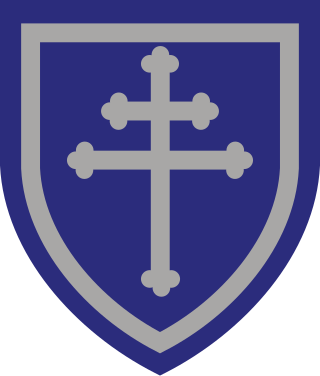
The 79th Infantry Division was an infantry formation of the United States Army Reserve in World Wars I and II.

The 81st Readiness Division ("Wildcat") was a formation of the United States Army originally organized as the 81st Infantry Division during World War I. After World War I, the 81st Division was allotted to the Organized Reserve as a "skeletonized" cadre division. In 1942, the division was reactivated and reorganized as the 81st Infantry Division and served in the Pacific during World War II. After World War II, the 81st Infantry Division was allotted to the Organized Reserve as a Class C cadre division, and stationed at Atlanta, Georgia. The 81st Infantry Division saw no active service during the Cold War and was inactivated in 1965.
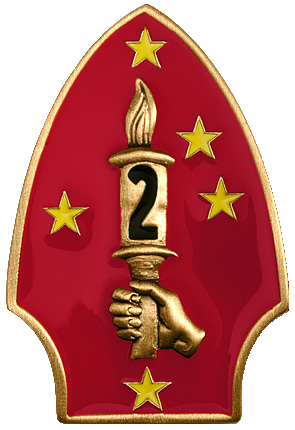
The 2nd Marine Division is a division of the United States Marine Corps, which forms the ground combat element of the II Marine Expeditionary Force. The division is based at Marine Corps Base Camp Lejeune, North Carolina and headquartered at Julian C. Smith Hall.
Edward Canfield Fuller was an officer in the United States Marine Corps and the son of General Ben Hebard Fuller.
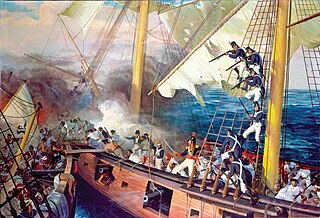
Marines are soldiers who primarily operate in littoral zones, both on land and at sea. Historically, the main tasks undertaken by marines have included raiding ashore in support of naval objectives, and the boarding of vessels during combat or capture of prize ships. Marines also help maintain discipline and order aboard the ship. In most countries, marines are an integral part of that state's navy.
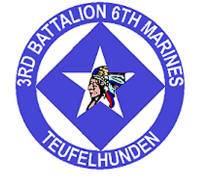
3rd Battalion, 6th Marines (3/6) is an infantry battalion in the United States Marine Corps based out of Camp Lejeune, North Carolina. Also known as "Teufelhunden", it consists of approximately 1000 Marines and Sailors. They fall under the 6th Marine Regiment and the 2nd Marine Division.

2nd Battalion, 6th Marines (2/6) is an infantry battalion in the United States Marine Corps based out of Camp Lejeune, North Carolina. Also known as "The Ready Battalion" or "2/6 Spartans", it consists of approximately 800 Marines and Sailors and falls under the command of the 6th Marine Regiment and the 2nd Marine Division.
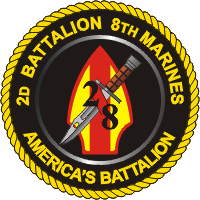
2nd Battalion, 8th Marines (2/8) is an infantry battalion in the United States Marine Corps based in Marine Corps Base Camp Lejeune, North Carolina consisting of approximately 900 marines and sailors. Nicknamed "America's Battalion," they fall under the 8th Marine Regiment and the 2nd Marine Division.

The 1st Battalion, 6th Marines (1/6) is an infantry battalion in the United States Marine Corps based in Camp Lejeune, North Carolina. It consists of approximately 1,100 marines and sailors. They fall under the command of the 6th Marine Regiment, the 2nd Marine Division of the II Marine Expeditionary Force.

The 6th Marine Regiment is an infantry regiment of the United States Marine Corps based at Marine Corps Base Camp Lejeune, North Carolina. The regiment falls under the command of the 2nd Marine Division of the II Marine Expeditionary Force. Its combat history dates back to World War I when they were part of the American Expeditionary Force. They fought in the Pacific Theater in World War II, most notably at the battles of Guadalcanal, Tarawa, Saipan, Tinian and Okinawa. More recently, the regiment has seen combat during the Gulf War and in support of Operation Iraqi Freedom.
A regimental combat team (RCT) is a provisional major infantry unit which has seen use by branches of the United States Armed Forces. It is formed by augmenting a regular infantry regiment with smaller combat, combat support and combat service support units.

The 1st Free French Division was one of the principal units of the Free French Forces (FFL) during World War II, renowned for having fought the Battle of Bir Hakeim.

The 39th Infantry Division was an infantry formation of the Army National Guard, originally formed as the 18th Division in 1917. The division consisted of troops from Arkansas, Louisiana, and Mississippi. After training at Camp Beauregard, Louisiana, the division was deployed to France but did not see combat before the end of World War I. In July 1923 the division was re-designated as the 31st Infantry Division. The 39th Infantry Division was reactivated after World War II with troops from Louisiana and Arkansas and its headquarters in Louisiana. In 1967, the 39th Infantry Division was reorganized to become the 39th Infantry Brigade (Separate). Its headquarters was in Little Rock and the unit consisted entirely of troops from Arkansas.

Troops began wearing berets as a part of the headgear of military uniforms in some European countries during the 19th century; since the mid-20th century, they have become a component of the uniforms of many armed forces throughout the world. Military berets are usually pushed to the right to free the shoulder that bears the rifle on most soldiers, but the armies of some countries, mostly within Europe, South America, and Asia, have influenced the push to the left.

The 2nd Infantry Brigade Combat Team is a unit of the Pennsylvania Army National Guard’s 28th Infantry Division. 2nd Brigade's headquarters is in Washington, Pennsylvania, and the brigade also contains units from Ohio and Maryland.

Joseph D. Patch was a career officer in the United States Army. A veteran of the Mexican Border War, World War I and World War II, his awards and decorations included the Distinguished Service Cross. Patch served from 1909 to 1945, and he attained the rank of major general as the Second World War commander of the 80th Infantry Division.
















